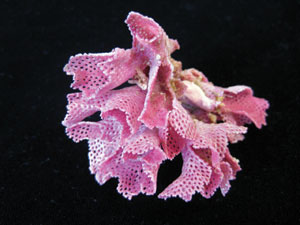Calcification in Changing Oceans Explored in Special Issue of The Biological Bulletin

Contact: Gina Hebert 508-289-7725; ghebert@mbl.edu
WOODS HOLE, MA—What do mollusks, starfish, and corals have in common? Aside from their shared marine habitat, they are all calcifiers—organisms that use calcium from their environment to create hard carbonate skeletons and shells for stability and protection.
The June issue of the Biological Bulletin, published by the Marine Biological Laboratory, addresses the challenges faced by these species as ocean composition changes worldwide.
 Branching coral Acropora sp. (Photo by Maria Byrne, University of Sydney)
Branching coral Acropora sp. (Photo by Maria Byrne, University of Sydney)As atmospheric carbon dioxide rises, the world’s oceans are becoming warmer and more acidic. This impact of global climate change threatens the survival of calcifying species because of the reduced saturation of the carbonate minerals required for calcification.
The ability to calcify arose independently in many species during the Cambrian era, when calcium levels in seawater increased. This use of calcium carbonate promoted biodiversity, including the vast array of calcifiers seen today.
“Today, modern calcifiers face a new and rapidly escalating crisis caused by warming and acidification of the oceans with a reduction in availability of carbonate minerals, a change driven by the increase in atmospheric CO2 due to anthropogenic emissions and industrialization. The CO2 itself can also directly cause metabolic stress,” write the issue’s co-editors, Maria Byrne of the University of Sydney; and Gretchen Hofmann of the University of California-Santa Barbara.
Contributors to the journal address this timely issue across many taxa and from a variety of perspectives, from genomic to ecosystem-wide.
Janice Lough and Neal Cantin of the Australian Institute of Marine Science review historical data on coral reefs to look at potential environmental stressors, while Philippe Dubois (Université Libre de Bruxelles) discusses sea urchin skeletons.
 Bryozoan Iodictyum yaldwyni (Photo by Abigail M. Smith, University of Otago)
Bryozoan Iodictyum yaldwyni (Photo by Abigail M. Smith, University of Otago)Other researchers address lesser-known organisms that are nevertheless critical to marine ecosystems. Abigail Smith of the University of Otago examines how bryozoans, a group of aquatic invertebrate filter-feeders, increase biodiversity by creating niche habitats, and what features make them particularly sensitive to calcium fluctuations.
Evans and Watson-Wynn (California State University-East Bay) take a molecular approach in a meta-analysis showing that ocean acidification is effecting genetic changes in sea urchin larvae. Several papers take a broader population-based view by studying the effect of ocean acidification on predator-prey interactions in mollusks (Kroeker and colleagues of the University of California-Davis) and oysters (Wright and colleagues of the University of Western Sydney).
“The contributors have identified key knowledge gaps in the fast evolving field of marine global change biology and have provided many important insights,” the co-editors write.
By sharing research on this topic from researchers around the world, the Biological Bulletin is raising awareness of some of the greatest threats to the oceans today and emphasizing the global nature of the problem.
—###—
The Biological Bulletin publishes outstanding experimental research in the areas of invertebrate neurobiology, comparative aspects of developmental biology, functional morphology and biomechanics, and aspects of comparative physiology and physiological ecology, such as symbiosis. It publishes peer-reviewed research papers, rapid communications, position papers, and invited review articles and symposia, six times a year. Published since 1897 by the Marine Biological Laboratory (MBL) in Woods Hole, Massachusetts, The Biological Bulletin is one of America’s oldest peer-reviewed scientific journals. It is aimed at a general readership and especially invites articles about those novel phenomena and contexts characteristic of intersecting fields. The electronic version, Biological Bulletin Online, contains the full content of each issue, including all figures and tables, beginning with the February 2001 issue. PDF files of the entire archive from 1897-2000 are also available.
The Marine Biological Laboratory (MBL) is dedicated to scientific discovery and improving the human condition through research and education in biology, biomedicine, and environmental science. Founded in Woods Hole, Massachusetts, in 1888, the MBL is a private, nonprofit institution and an affiliate of the University of Chicago.